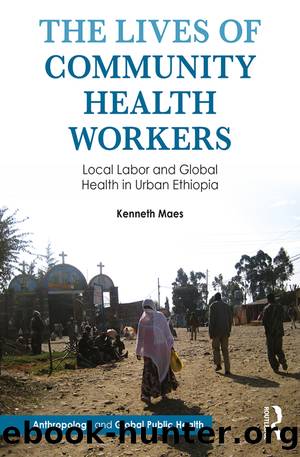The Lives of Community Health Workers by Kenneth Maes

Author:Kenneth Maes [Maes, Kenneth]
Language: eng
Format: epub
Tags: Health & Fitness, Diseases, Aids & Hiv, Medical, Caregiving, Home Care, Public Health, Political Science, Public Policy, Social Services & Welfare, Social Security, Social Science, Anthropology, General, Sociology
ISBN: 9781315400778
Google: 0iglDwAAQBAJ
Publisher: Taylor & Francis
Published: 2016-12-15T04:30:52+00:00
Photo courtesy of the author.
During the third week of the training, Tirusew instructed the trainees on how to collect and report dataâspecifically data describing their CHW activities, which were to be used for monitoring and evaluation (Figure 3.2). Tirusew defined monitoring and evaluation, noting that the former enables the latter. He expounded on the importance of data quality and âgood record keeping,â starting at the volunteer CHW level. âWell organized records will show whether your work is improving and which areas need improvement or change.â During his lecture, Tirusew showed the trainees an organogram depicting the hierarchical relationship between patients, volunteers, supervisors, team leaders, coordinators, directors, and finally, FHI. In the organogram, data and evaluation reports moved up and down this hierarchy, and each level in the hierarchy had its associated forms to fill and weekly, monthly, or quarterly âreview meetings,â comprising a âmonitoring system.â Tirusew summarized this set of relationships by emphasizing that âit is very necessary for volunteers to be familiar with their forms, because this will help the supervisors present their reports to their coordinator.â
After introducing the forms and their use in lecture, Tirusew and the other supervisors led the trainees outside the hall and divided them into groups of seven or eight individuals. They received and studied copies of the forms that the they would use in data collection and weekly reporting: a volunteer CHWâs Weekly Activity Planning form, a Weekly Activity Reporting form, and a Self-Reflection Form, all adorned by FHIâs logo. Given hypothetical narrative descriptions of a patient and a volunteerâs visit to that patientâs home, including the name and age of the patient, whether or not she was a new patient, some clinical and demographic data, the time of the visit, and what kinds of services were performed during the visit (cleaning, medicine assistance, sick care, etc.), the trainee groups practiced filling out both the weekly reporting form and the planning form for the next week. Finally, the groups discussed how well each had filled out their planning form, identifying and building consensus on errors and inconsistencies.
CHWs were thus expected to work with multiple kinds of technical, biomedical, and bureaucratic knowledge and practices: HIV subtypes, opportunistic infections, and ART regimens; wards, labs, pharmacies, HIV/AIDS desks, and data card rooms; data collection for monitoring and evaluation, and so on (Figure 3.3). The tendency to refer to patients with bureaucratic terms like âclientâ or âbeneficiary,â and the white coats that the trainees wore while at the hospital and in a group photo-op on the last day of training, can be read as signs that CHWs were seen and saw themselves as extensions of biomedicine and of bureaucratic institutions.
Yet if mediating technical forms of biomedicine and collecting data were important parts of their job, from the looks of the training, so was being a force of anti-stigmatization, solidarity, support, hope, and improved quality of life for patients and families. Even as NGO and government health officials in charge of scaling-up ART access in Addis Ababa emphasized
Download
This site does not store any files on its server. We only index and link to content provided by other sites. Please contact the content providers to delete copyright contents if any and email us, we'll remove relevant links or contents immediately.
Human Diseases (MindTap Course List) (by Team-IRA) by Marianne Neighbors Ruth Tannehill-Jones(846)
The Neglected Dimension of Global Security: A Framework to Counter Infectious Disease Crises by National Academy of Medicine Secretariat(422)
Statistical Methods in Health Disparity Research by J. Sunil Rao(399)
Imaging in Urology by Mitchell Tublin MD Joel B Nelson MD(397)
Cancer Cell Culture by Unknown(363)
Short Course in Medical Terminology by Nath Judi L.;(331)
Wilkins' Clinical Practice of the Dental Hygienist by Boyd Linda D.;Mallonee Lisa F.; & Lisa F. Mallonee(302)
Clinical Research in Occupational Therapy, Sixth Edition by Martin Rice;(300)
Murray's Basic Medical Microbiology E-Book by Murray Patrick R.;(282)
Anatomical Kinesiology by Gross Michael;(281)
Health Behavior: Theory, Research, and Practice by Karen Glanz & Barbara K. Rimer & K. Viswanath(276)
Psychedelics As Psychiatric Medications by Nutt David;Castle David;(272)
Neuroscience Fundamentals for Rehabilitation by Lundy-Ekman Laurie(271)
Achieving Procreation : Childlessness and IVF in Turkey by Merve Demircioğlu Göknar(258)
Rang & Dale's Pharmacology 9th Edition plus Flashcards 2nd Edition by Unknown(252)
Public Health and Society: Current Issues by Burke Lillian D.;Weill Barbara;(246)
The Handbook of Medicinal Chemistry by Simon E Ward;Andrew Davis;(245)
Primary Care Occupational Therapy by Unknown(239)
Brown's Evidence-Based Nursing: the Research-Practice Connection by Nowak Emily W.;Colsch Renee; & Renee Colsch(233)
